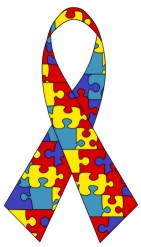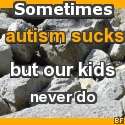 Image via Wikipedia
Image via Wikipedia
First, the medical jargon, and then the definition follows: The DSM IV defines Diagnostic Criteria
in order to be diagnosed with autism or Asperger's Syndrome:
Diagnostic Criteria for 299.00 Autistic Disorder
1. A total of six (or more) items from (1), (2), and (3), with at least two from (1), and one each from (2) and (3):
1. qualitative impairment in social interaction, as manifested by at least two of the following:
1. marked impairment in the use of multiple nonverbal behaviors such as eye-to-eye gaze, facial expression, body postures, and gestures to regulate social interaction
2. failure to develop peer relationships appropriate to developmental level
3. a lack of spontaneous seeking to share enjoyment, interests, or achievements with other people (e.g., by a lack of showing, bringing, or pointing out objects of interest)
4. lack of social or emotional reciprocity
2. qualitative impairments in communication as manifested by at least one of the following:
1. delay in, or total lack of, the development of spoken language (not accompanied by an attempt to compensate through alternative modes of communication such as gesture or mime)
2. in individuals with adequate speech, marked impairment in the ability to initiate or sustain a conversation with others
3. stereotyped and repetitive use of language or idiosyncratic language
4. lack of varied, spontaneous make-believe play or social imitative play appropriate to developmental level
3. restricted repetitive and stereotyped patterns of behavior, interests, and activities, as manifested by at least one of the following:
1. encompassing preoccupation with one or more stereotyped and restricted patterns of interest that is abnormal either in intensity or focus
2. apparently inflexible adherence to specific, nonfunctional routines or rituals
3. stereotyped and repetitive motor manners (e.g., hand or finger flapping or twisting, or complex whole-body movements)
4. persistent preoccupation with parts of objects
2. Delays or abnormal functioning in at least one of the following areas, with onset prior to age 3 years: (1) social interaction, (2) language as used in social communication, or (3) symbolic or imaginative play.
3. The disturbance is not better accounted for by Rett’s Disorder or Childhood Disintegrative Disorder.
Diagnostic Criteria for 299.80 Asperger's Disorder
1. Qualitative impairment in social interaction, as manifested by at least two of the following:
1. marked impairment in the use of multiple nonverbal behaviors such as eye-to eye gaze, facial expression, body postures, and gestures to regulate social interaction
2. failure to develop peer relationships appropriate to developmental level
3. a lack of spontaneous seeking to share enjoyment, interests, or achievements with other people (e.g., by a lack of showing, bringing, or pointing out objects of interest to other people)
4. lack of social or emotional reciprocity
2. Restricted repetitive and stereotyped patterns of behavior, interests and activities, as manifested by at least one of the following:
1. encompassing preoccupation with one or more stereotyped and restricted patterns of interest that is abnormal either in intensity of focus
2. apparently inflexible adherence to specific, nonfunctional routines or rituals
3. stereotyped and repetitive motor mannerisms (e.g., hand or finger flapping or twisting, or complex whole-body movements)
4. persistent preoccupation with parts of objects
3. The disturbance causes clinically significant impairment in social, occupational, or other important areas of functioning.
4. There is no clinically significant general delay in language (e.g., single words used by age 2 years, communicative phrases used by age 3 years).
5. There is no clinically significant delay in cognitive development or in the development of age-appropriate self-help skills, adaptive behavior (other than in social interaction), and curiosity about the environment in childhood.
6. Criteria are not met for another specific Pervasive Developmental Disorder or Schizophrenia.
But what does this really mean, to a parent? What are some warning signs, and when should you worry?
An infant is less likely to:- make eye contact
- respond to his or her name
- imitate those around him
- follow objects visually
- smile reciprocally , if you smile, baby doesn't smile back
- babble or make noise
- may have motor issues
- weakness in trunk, or hypotonia, lack of muscle tone
- may not meet developmental milestones within reasonable amount of time
Babies that are passive and inactive at six months, then extremely irritable at a year have a higher risk of autism, according to the Harvard Medical School. If you suspect your baby has autism, definitely seek help from your pediatrician. With autism, the sooner the interventions occur, the better.
In children autism can manifest by:- lack of speaking
- sing-song speech, or speech has strange cadence
- repeated phrases, called echolalia
- avoiding eye contact
- inability of pretend play (or, conversely, losing himself in play for hours alone)
- cannot make his needs known, may grunt or other non-verbal communication
- uses people as tools; may use your hand to point at things
- sensitivity to sights, smells sounds
- unusual fears (bugs, sounds, bathtime)
- lack of response to audio commands; may not respond to his name or requests; in his own world
- may have a lack of interest in others
- shows a lack of empathy and may not be able to express feelings; may not even know what she is feeling
- prefers lack of contact, or conversely, holds too tightly, needs a lot of contact
- rigid, has a hard time adapting to changes in routine
- can line things up, or need things arranged in a certain way
- repetitive actions
- one or more niche interests, that border on the obsessive
- sleep disturbances, inability to stay asleep
- highly anxious, especially when routine or preferred activities are disrupted
Know that in each child, autism presents differently. The hallmarks are there, but can be expressed in ways you wouldn't expect.
Siblings often will try to speak for a younger child, this does not necessarily point to autism. Encourage the child to speak for himself.
For example, a child may seem to have pretend play, but is it alone? Is it rigid? Does the child play well with others, and adapt them into the game, allowing the other child to make suggestions? Or does the child have difficulty handling the new playmate?
Many child insist upon wearing the same clothes, but most do not refuse to leave the house or become distraught over the possibility of something different. Kids with autism can be extremely rigid.
A child may not line items up, but do they spend time creating elaborate set ups and become upset if someone moves the toys? This could also be a sign.
Tantrums and lack of self-control are normal for a two year old. The child is trying to find his own identity. A seven year old, however, has mostly learned to control himself. If tantrums continue into middle childhood, it can be a flag.
Some sites for online evaluation help:
Autism Treatment Evaluation Checklist (ATEC)Childbrain.com PDD Assessment Questionnaire
Modified Checklist For Autism In Toddlers (M-CHAT)
Australian Scale For Asperger's Syndrome
I wrote this article for my section on special needs at Type-A Mom. You'll find more articles like this there.
Some of the things I have written about:
Autism and FearsPower Struggles and Autism
How to Convert to the Gluten-Free Casein-Free Diet (GFCF Diet)
Helping your child cope with anxiety
The Importance of Early Interventions For Autism Treatment
There are many more. If you want more info, be sure to email me:
sendchocolatenow[AT]gmail[DOT]com
You can find more of my articles at: Type A Mom sendchocolate I am the Special Needs Parenting Editor there.
Sources:
Kirby, Barbara "DIAGNOSTIC RATING SCALES FOR ASPERGER SYNDROME" Diagnostic Ratings Scales for Asperger Syndrome" O.A.S.I.S.
Diagnostic Criteria for Autism and Asperger's Syndrome CDC.gov
Autism Symptom Checklist autism-pdd.net
Harvard Health Publications Harvard Medical School "Searching for Early Signs of Autism Spectrum Disorders" < cid="M1107b"> 2007
![Reblog this post [with Zemanta]](http://img.zemanta.com/reblog_e.png?x-id=f0e0abd6-ffbb-46e9-9d58-f983b93030f6)

































2 sent chocolate:
I really love Your site! It is helpful and very informative!
My brother has Asperger's Syndrome and I have been diagnosed with Paranoid Schizophrenia.
Sorry about my Twitter 'spamming'! I am learning and doing my best!
CHOCOLATE RULES!!
Thanks,
Regards,
Dave.
This is great info and fluently presented. Thanks for that. Next time someone asks me to explain Autism, I might just refer them here!
Post a Comment